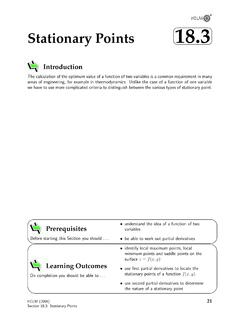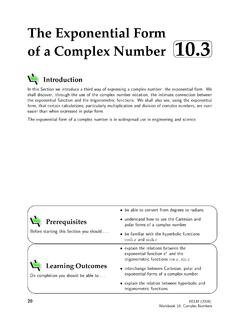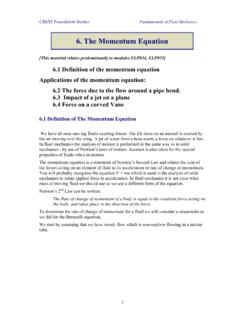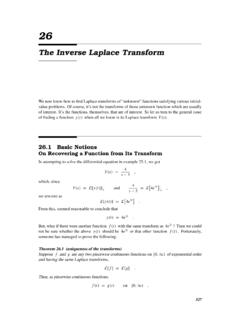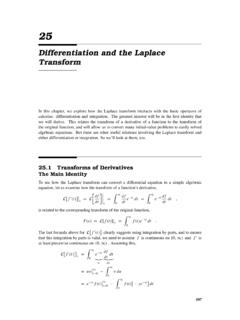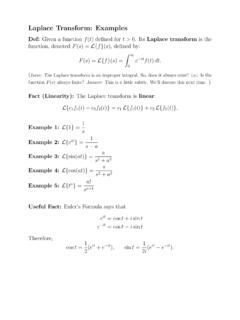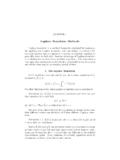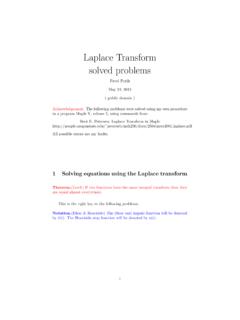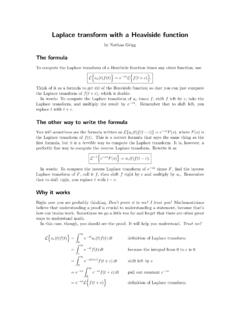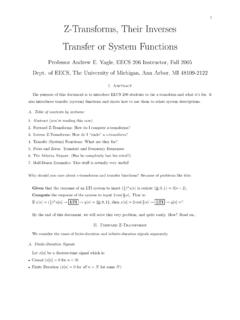Transcription of Solving Differential Equations
1 Solving DifferentialEquations this Section we employ the laplace transform to solve constant coefficient ordinary differentialequations. In particular we shall consider initial value problems. We shall find that the initialconditions are automatically included as part of the solution process. The idea is simple; the Laplacetransform of each term in the Differential equation is taken. If the unknown function isy(t)then, ontaking the transform , an algebraic equation involvingY(s) =L{y(t)}is obtained. This equation issolved forY(s)which is then inverted to produce the required solutiony(t) =L 1{Y(s)}.'&$%PrerequisitesBefore starting this Section you should.. understand how to find laplace transforms ofsimple functions and of their derivatives be able to find inverse laplace transformsusing a variety of techniques know what an initial-value problem is Learning OutcomesOn completion you should be able to.. solve initial-value problems using the Laplacetransform method34 HELM (2008):Workbook 20: laplace Transforms 1.
2 Solving ODEs using laplace transformsWe begin with a straightforward initial value problem involving a first order constant coefficientdifferential equation. Let us find the solution ofdydt+ 2y= 12e3ty(0) = 3using the laplace transform it is not stated explicitly we shall assume thaty(t)is a causal function (we have no interestin the value ofy(t)ift <0.) Similarly, the function on the right-hand side of the Differential equation(12e3t), the forcing function , will be assumed to be causal. (Strictly, we should write12e3tu(t)butthe step functionu(t)will often be omitted.) Let us writeL{y(t)}=Y(s). Then, taking the Laplacetransform of every term in the Differential equation gives:L{dydt}+L{2y}=L{12e3t}NowL{dydt}= y(0) +sY(s) = 3 +sY(s)L{2y}= 2Y(s)andL{12e3t}=12s 3 Substituting these expressions into the transformed version of the Differential equation gives:[ 3 +sY(s)] + 2Y(s) =12s 3 Solving forY(s)we have(s+ 2)Y(s) =12s 3+ 3 =3 + 3ss 3 ThereforeY(s) =3(s+ 1)(s+ 2)(s 3)Now, using partial fractions, this last expression can be written in a more convenient form:Y(s) =3/5(s+ 2)+12/5(s 3)and then, inverting:y(t) =L 1{Y(s)}=35L 1{1s+ 2}+125L 1{1s 3}thusy(t) =35e 2tu(t) +125e3tu(t)This is the solution to the given initial value (2008):Section : Solving Differential Equations35 TaskThe equation governing the build up of charge,q(t), on the capacitor of an RCcircuit isRdqdt+1Cq=v0 RCwherev0is the constant voltage.
3 Initially, the circuit is relaxed and the circuitis then closed att= 0and soq(0) = 0is the initial condition for the the laplace transform method to solve the Differential equation forq(t).Assume the forcing termv0is by finding an expression forQ(s) =L{q(t)}:Your solutionAnswerQ(s) =v0Cs(RCs+ 1)since, taking the laplace transform of each term in the Differential equation:RL{dqdt}+1CL{q}=L{v0} [ q(0) +sQ(s)] +1CQ(s) =v0swhere, we emphasize, the laplace transform of the constant (0) = 0we have, after some rearrangement,Q(s) =v0Cs(RCs+ 1)36 HELM (2008):Workbook 20: laplace Transforms Now expand the expression using partial fractions:Your solutionAnswerYou should obtainQ(s) =v0C[1s RCRCs+ 1]Now obtainq(t)by taking inverse laplace transforms:Your solutionAnswerq(t) =v0C(1 e t/RC)u(t)sinceL 1{1s}= 1andL 1{RCRCs+ 1}=L 1{1s+ (1/RC)}=e t/RCThe solution to this problem is illustrated in the following (t)tv 0 CThe laplace transform method is also applied to higher-order Differential Equations in a similar (2008):Section : Solving Differential Equations37 Example 1 Solve the second-order initial-value problem.
4 D2ydt2+ 2dydt+ 2y=e ty(0) = 0, y (0) = 0using the laplace transform usual we shall assume the forcing function is causal ( is really e tu(t).0 Taking the Laplacetransform of each term:L{d2ydt2}+ 2L{dydt}+ 2L{y}=L{e t}that is,[ y (0) sy(0) +s2Y(s)] + 2[ y(0) +sY(s)] + 2Y(s) =1s+ 1 Inserting the initial conditions and rearranging:Y(s)[s2+ 2s+ 2] =1s+ (s) =1(s+ 1)(s2+ 2s+ 2)Then, using partial fractions:1(s+ 1)(s2+ 2s+ 2) 1s+ 1 (s+ 1)s2+ 2s+ 2 1s+ 1 (s+ 1)(s+ 1)2+ 1where we have completed the square in the second term of the right-hand side. We can now takethe inverse laplace transform :y(t) =L 1{Y(s)}=L 1{1s+ 1} L 1{s+ 1(s+ 1)2+ 1}= (e t e tcost)u(t)which is the solution to the initial value laplace transforms to +x= 9e2tx(0) = +x= 2tx(0) = 0x (0) = (t) = (t) = 3 sint+ 2t38 HELM (2008):Workbook 20: laplace Transforms Example 2A damped spring, constrained to move in one direction, such as might be foundin a railway buffer, is subjected to an impulse of duration 5 seconds.)
5 The springconstant divided by the mass causing the impulse is 10 m 2s 2and the frictionalforce divided by this mass is 2 m 2s 2.(a)Write down the equation governing the motion in terms of the displace-mentxm and timetseconds including the impulseu(t).(b)Write down the initial conditions on the displacement(x)and velocity.(c)Solve the equation for displacement as a function of time.(d)Draw a graph of the oscillations fort= 0to 10 (a)Since the system involves a restoring force and friction, after dividing through by themass, the equation of motion may be written:d2xdt2+ 2dxdt+ 10x=u(t) u(t 5)where the right-hand side represents the impulse being switched on att= 0s andswitched off att= 5s.(b)Since the system starts from restx(0) =x (0) = 0.(c)Taking the laplace transform of each term of the Differential equation givesL[d2xdt2]+ 2L[dxdt]+ 10L[x] =L[u(t)] L[u(t 5)] (s) s x(0) x (0) + 2(s X(s) x(0)) + 10X(s) =1s 1se 5sbut asx(0) =x (0) = 0, this simplifies tos2X(s)+2s X(s)+10X(s) =1s[1 e 5s] (s) =1s(s2+ 2s+ 10)[1 e 5s]=[110 1s 110 s+ 2s2+ 2s+ 10][1 e 5s](using partial fractions)=[110 1s 110 s+ 1(s+ 1)2+ 32 130 3(s+ 1)2+ 32][1 e 5s]=110 1s 110 s+ 1(s+ 1)2+ 32 130 3(s+ 1)2+ 32 110 1se 5s+110 s+ 1(s+ 1)2+ 32e 5s+130 3(s+ 1)2+ 32e 5sHELM (2008):Section : Solving Differential Equations39 Solution (contd.)
6 So, on taking inverse laplace Transforms,x(t) =110 110e tcos 3t 130e tsin 3t 110u(t 5) +110e (t 5)cos 3(t 5)u(t 5) +130e (t 5)sin 3(t 5)u(t 5)(d)x(t)t 16 According to the graph the damped spring has a damped oscillation about a displacement of after the start of the impulse and a damped oscillation about a displacement of zero after theimpulse has Solving systems of Differential equationsThe laplace transform method is also well suited to Solving systems of Differential Equations . Asimple example will illustrate the (t), y(t)be two independent functions which satisfy the coupled Differential equationsdxdt+y=e tdydt x= 3e tx(0) = 0, y(0) = 1 Now, using a traditional approach, we could try to eliminate one of the unknown functions from thissystem: for example, from the first:dydt= e t d2xdt2(taking the derivative and rearranging)This can then be substituted in the second equation:dydt x= 3e t, to give: d2xdt2 x= 4e t40 HELM (2008):Workbook 20: laplace Transforms which can then be solved in the normal way (either using the complementary function/particularintegral approach or else the laplace transform approach.)
7 However, this approach is not workableif we have large numbers of first order Differential Equations to deal with. Let us instead use theLaplace transform we use the notation thatL{x(t)}=X(s)andL{y(t)}=Y(s)then, by taking the laplace transform of every term in the given Differential Equations , we obtain: x(0) +sX(s) +Y(s) =1s+ 1 y(0) +sY(s) X(s) =3s+ 1which, using the initial conditions and rearranging givessX(s) +Y(s) =1s+ 1 X(s) +sY(s) =s+ 4s+ 1 Key Point 13 Taking the laplace transform converts a system of Differential equationsinto a system of algebraic simultaneous can solve these algebraic Equations (inX(s)andY(s)) using a variety of techniques (inversematrix; Cramer s determinant method etc.) Here we will use Cramer s (s) = 1s+11s+4s+1s s1 1s =ss+ 1 s+ 4s+ 1s2+ 1= 4(s2+ 1)(s+ 1)=2(s 1)s2+ 1 2s+ 1andY(s) = s1s+1 1s+4s+1 s1 1s =s(s+ 4)s+ 1+1s+ 1s2+ 1=s2+ 4s+ 1(s2+ 1)(s+ 1)= 1s+ 1+2(s+ 1)s2+ 1 HELM (2008):Section : Solving Differential Equations41 The last lines in each case having been obtained using partial fractions.
8 We can now invertX(s), Y(s)to findx(t), y(t):x(t) =L 1{X(s)}= 2L 1{ss2+ 1} 2L 1{1s2+ 1} 2L 1{1s+ 1}= (2 cost 2 sint 2e t)u(t)y(t) =L 1{Y(s)}= L 1{1s+ 1}+ 2L 1{ss2+ 1}+ 2L 1{1s2+ 1}= ( e t+ 2 cost+ 2 sint)u(t)(Note that once the solution forx(t)is found the solution fory(t)may be easier to obtain bysubstituting in the Differential equation:y=e t dxdtrather than using laplace transforms.)TaskUse the laplace transform to solve the coupled Differential Equations :dydt x= 0,dxdt+y= 1,x(0) = 1, y(0) = 1 Begin by obtaining a system of algebraic Equations forX(s)andY(s):Your solutionAnswerWritingL{x(t)}=X(s)andL{y( t)}=Y(s)you should obtain the set of transformed Equations 1 +sY(s) X(s) = 01 +sX(s) +Y(s) =1swhich, when re-arranged, are X(s) +sY(s) = 1sX(s) +Y(s) =1 ssNow solve these Equations forX(s)andY(s):Your solution42 HELM (2008):Workbook 20: laplace Transforms AnswerX(s) = s1 +s2Y(s) =1s 11 +s2 Now find the required solution by obtaining the inverse laplace transforms:Your solutionAnswerYou should obtainx(t) = (t)andy(t) = (1 sint).
9 U(t). This follows sinceL 1{ s1 +s2}= (t)L 1{1s}=u(t)L 1{ 11 +s2}= (t) the given system of Differential Equations for the initial conditions specified.(a)dxdt=ydydt=xx(0) = 1y(0) = 0(b)dxdt= 4x 2ydydt= 5x+ 2yx(0) = 2y(0) = laplace transform can also be used to solve a pair of coupled second order , for the given initial conditions,d2xdt2=y+ sintx(0) = 1x (0) = 0d2ydt2= dxdt+ costy(0) = 1y (0) = 1(Note that the initial conditions on each ofx(t)andy(t)are needed in the second ordersituation.)Answer1.(a)x= cosht, y= sinht(b)x=e3t(2 cos 3t+ 2 sin 3t), y=e3t( 2 cos 3t+ 4 sin 3t) cost, y= cost sintHELM (2008):Section : Solving Differential Equations433. Applications of systems of Differential equationsCoupled electrical circuits and mechanical vibrating systems involving several masses in springs offerexamples of engineering systems modelled by systems of Differential circuitsConsider the RL (resistance/inductance) circuit with a voltagev(t)applied as shown in Figure (t)Figure 17 Ifi1andi2denote the currents in each loop we obtain, using Kirchhoff s voltage law:(i) in the right loop:L1di1dt+R2(i1 i2) +R1i1=v(t)(ii) in the left loop:L2di2dt+R2(i2 i1) = 0 TaskSuppose, in the above circuit, thatL1= ,L2= 1henry,R1= R2= 1.
10 Assume zero initial conditions:i1(0) =i2(0) = that the applied voltage is constant:v(t) = 100voltst the problem by laplace by obtainingV(s), the laplace transform ofv(t):Your solution44 HELM (2008):Workbook 20: laplace Transforms AnswerWe have, from the definition of the laplace transform :V(s) = 0100e stdt= 100[e st s] 0=100sThis is simply the laplace transform of the step function of height insert the parameter values into the Differential Equations and obtain the laplace transform ofeach equation. Denote byI1(s), I2(s)the laplace transforms of the unknown currents. (These areequivalent toX(s)andY(s)of the theory.):Your +i1 i2+ (t)di2dt+i2 i1= 0 Rearranging and dividing the first equation by :di1dt+ 3i1 (t)di2dt i1+i2= 0 Taking laplace transforms and inserting the initial conditionsi1(0) = 0, i2(0) = 0:(s+ 3)I1(s) (s) =125s I1(s) + (s+ 1)I2(s) = 0 HELM (2008):Section : Solving Differential Equations45 Now solve these Equations forI1(s)andI2(s).

